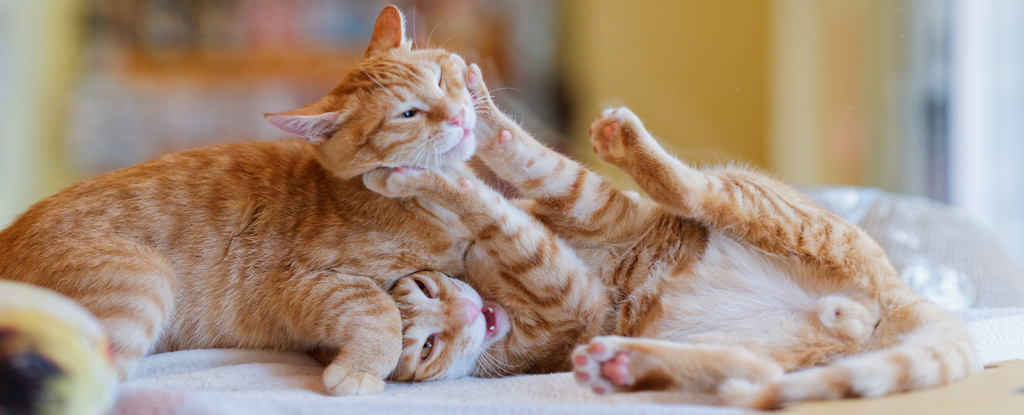Have you ever worried if play between your cats was getting too rough? A new study Published in Scientific Reports studied play and fighting in cats.
Their goal was to use simple behaviors that anyone could observe to figure out what play was and what might lead to fights.
This is important because the Fighting results in injuries to animals and people. At worst, you may even have to move one of your cats to a new home if they don’t get along.
Cat fights categorize
The study, led by Noema Gajdos-Kmecova from the University of Veterinary Medicine and Pharmacy in Slovakia and from the University of Lincoln, UK analyzed 105 videos of interactions between 210 cats.
The research team back then developed an ethogram – a list of specific behaviors used in the study of animal behavior. These were divided into six groups:
- Inactive: head and body motionless and in a certain position, such as squatting
- Wrestling: Cats in physical contact with wrestling moves
- Chasing: A cat runs after or another cat runs away
- Other interactive activities: e.g. B. Grooming, approaching, putting up the fur on the back
- Non-interactive: Activity directed towards self or an inanimate object, e.g. B. Drinking, self-licking
- Vocalizations: for example, growls, hisses, meows
Each video was analyzed to determine which of these behaviors were exhibited by each cat. Each interaction was then statistically analyzed to find out which behaviors appeared together in clusters.
From this, the researchers divided the videos into three categories of interactions.
Playful: included 40 percent of the cats from the videos and included wrestling and a lack of vocalization.
agonistic: agonistic behaviors are all social behaviors that involve threats, aggression, and submission. Cats in this group were vocal and had recurrent bouts of inactivity; 32 percent of the cats in the sample ended up in this group.
intermediate: This group comprised 28 percent of the cats and was more closely associated with the playful group than with the agonistic group. Cats in this group interacted for longer periods of time with pauses in between.
As a cross-check, these behavioral categories observed in the videos corresponded fairly well to how the four authors, experts in cat behavior, described each interaction.
What does that tell you about your cats’ play?
When your cats wrestle, they are most likely playing. When there is friction between cats in a multi-cat household, they tend to avoid physical contact. Instead, they use offensive or defensive maneuvers that do not involve extensive direct contact, such as B. Slaps.
If your cats are vocalizing and chasing between periods of inactivity (e.g. crouching), they are most likely fighting.
Vocalization is a particularly important indicator of aggressive rather than playful interaction.
Chasing is fine when it’s mutual, but when a cat chases or runs away, that’s not so positive.
The intermediate group is the tricky one. It contains elements of both playful and agonistic behaviors, but was more closely related to the playful than to the agonistic group.
This suggests that could play will agonistic, depending on what is happening during the interaction.
In particular, the authors observed frequent pauses within the interaction, which might allow cats to reassess their partner’s interest in play and avoid an escalation from play to aggression.
The big fights are easy to spot
This study is the first to apply a scientific approach to cat behavior that anyone can identify, describing three types of interactions to help cats distinguish between play and fight.
We all know when cats are Yes, really struggle, but the main strength lies in working out in-between examples – where it could be ok, but could also escalate.
The study focused on obvious behaviors that anyone can observe, but cats can also be quite subtle.
They also use facial expression, ear and tail placement, and pheromones to communicate. (These subtle signals can be just as important in distinguishing between what’s playing and what’s fighting.
If your cats are truly besties (sleeping in close contact and sharing food and toys), the occasional agonistic play is fine.
But if your cats don’t get along very well, you may need to watch for signs of agonistic behavior. Tensions between cats are not always obvious, but they can affect their physical and mental health.
If you’re unsure whether your cats really get along, seeking help from a cat behavior expert early can prevent feline atrophy.
Susan HaselAssociate Professor, Faculty of Animal and Veterinary Sciences, University of Adelaide and Julia Henninggraduate student, University of Adelaide
This article is republished by The conversation under a Creative Commons license. read this original article.





